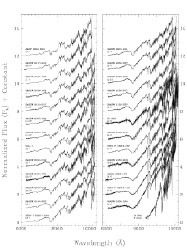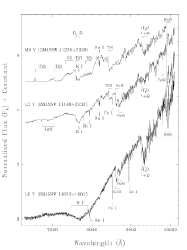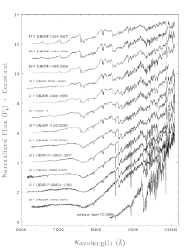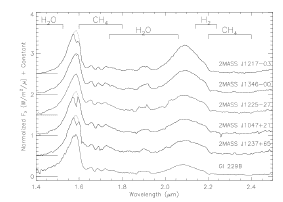 The Two Micron All Sky Survey at IPAC
The Two Micron All Sky Survey at IPAC
|
|
|
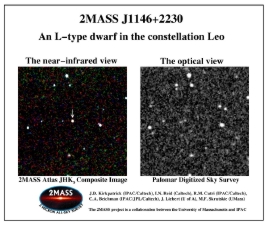 Low-Mass Stars and Brown Dwarfs in 2MASS
Low-Mass Stars and Brown Dwarfs in 2MASS
The current estimate of the density of L dwarfs is ~1 per 10 square degrees,
or ~4000 L dwarfs in the whole sky, for Ks<=15.0.
Preliminary calculations for the mass function indicate that L dwarfs (and
the methane-dominated T dwarfs) are twice as numerous as stars.
However, they make up only a small fraction of the mass of the
Milky Way Galaxy, a mere 15% of what the stars comprise.
Preprints and other materials for papers on low-mass stars
and brown dwarfs
- Dwarfs Cooler than ``M'': The Definition of Spectral
Type ``L'' using Discoveries from the Two Micron All Sky Survey (2MASS)
- GD 165B - The Prototype L Dwarf
- A 2MASS Late-M Superflare Star
- The Mass Function of Brown Dwarfs
- A 2MASS Survey for Brown Dwarfs Towards the Hyades
- Discovery of Four Field Methane (T-type) Dwarfs with 2MASS
- Two Nearby M Dwarf Binaries from 2MASS
- Four Nearby L Dwarfs
- BRI0021-0214: Another Surprise at the Bottom of the Main Sequence
Dwarfs Cooler than ``M'': The Definition of Spectral
Type ``L'' using Discoveries from the Two Micron All Sky Survey (2MASS)
J. Davy Kirkpatrick (IPAC/Caltech), I. Neill Reid (Caltech), J. Liebert
(UofA), R.M. Cutri, B. Nelson, C.A. Beichman (IPAC/Caltech), C.C. Dahn, D.G.
Monet (USNO-FS), J.E. Gizis, M.F. Skrutskie (UMass)
The Astrophysical Journal, 519, 802 (1999).
Abstract: Before the Two Micron All Sky Survey (2MASS) began, only six
objects were known with spectral types later than M9.5 V.
In the first 371 sq. deg. of actual 2MASS survey data, we have identified
another twenty such objects spectroscopically confirmed using the Low
Resolution Imaging Spectrograph (LRIS) at the W. M. Keck Observatory.
Because the TiO and VO bands which dominate the far-optical portions of late-M
spectra disappear in these cooler dwarfs, we define a new spectral class -
``L'' - where metallic oxides are replaced by metallic hydrides and neutral
alkali metals as the major spectroscopic signatures. We establish
classification indices and type all twenty-five L dwarfs. The
twenty-sixth ``post-M9.5'' object - Gl 229B - is the prototype of a
methane-dominated spectral class which we propose as class ``T''.
At least five of the twenty 2MASS L dwarfs show the 6708 Å lithium
doublet at low resolution, the strongest having an equivalent width of
18.5 Å. For objects this cool, the presence of lithium proves that they
are substellar. Two other 2MASS objects appear to have lithium lines at the
limit of our detectability, which if verified means that at least a third
of our L dwarfs are bona fide brown dwarfs. All of the 2MASS brown dwarfs
discovered so far have J-Ks > 1.30. We have not yet,
despite deliberately searching for them, found any brown
dwarfs with colors resembling Gl 229B (J-Ks ~ -0.1).
Example spectra of L dwarfs and comparisons to late-M dwarfs and Gl 229B:
Color-color diagram showing locations of M dwarfs, L dwarfs, and Gl 229B:
An Improved Optical Spectrum and New Model Fits of the Likely Brown
Dwarf GD 165B
J. Davy Kirkpatrick (IPAC/Caltech), France Allard (Lyon), Tom Bida (Keck),
Ben Zuckerman, E.E. Becklin (UCLA), Gilles Chabrier, and Isabelle Baraffe
(Lyon)
The Astrophysical Journal, 519, 834 (1999).
Abstract: Long thought by some researchers to be an oddity, GD 165B has
instead proven to be the first example of a class of very cool objects (the L
dwarfs) which, due to dust formation in their photospheres, lack the dominant
bands of TiO seen in warmer M dwarfs. Here we present an improved optical
(6200-10300 Å) spectrum of GD 165B and identify its prominent
spectral features. Among these are newly identified bands of FeH
and the first identification of CrH bands in a dwarf. We
use the latest generation of model atmospheres, which include the
effects of condensation and dust opacities, to derive values of Teff
=1900±100K and log(g) = 5.0±0.5 for GD 165B.
We also derive a crude age of 1.2 to 5.5 Gyr for the GD 165 system. A
comparison of the temperature and age of GD 165B to evolutionary models
predicts GD 165B to be an object in the transition zone between stars and
brown dwarfs. Further observational evidence - the discovery of
lithium in other dwarfs spectroscopically similar to
GD 165B and the scarcity of GD 165B-like companions found by imaging
surveys - favors a substellar interpretation for this object. We argue that the
weight of this observational evidence together with the known shortcomings
of the evolutionary models (which do not yet include opacity by grains)
indicate that GD 165B is probably a brown dwarf.
A 2MASS Ultracool M Dwarf Observed in a Spectacular Flare
J. Liebert (UofA), J. Davy Kirkpatrick (IPAC/Caltech), I. Neill Reid
(Caltech), M.D. Fisher (UofA)
The Astrophysical Journal, 519, 345 (1999).
Abstract: 2MASSW J0149090+295613 (hereafter 2M0149) is unique among the
very late M/L dwarf counterparts to 2MASS point sources in having shown, in
the first set of spectra taken on 1997 Dec 7, a diverse emission line
spectrum at red wavelengths, featuring an H-alpha equivalent width of
300Å. On four repeat observations, however, the spectrum was that of
a more ordinary dMe object, albeit with a late spectral type of M9.5 V.
Our interpretation is that the object underwent an extreme magnetic
flare event. The continuum flux at the short wavelength end of the
spectrum was also several times stronger during the apparent flare
than in quiescence. Comparison is made with mid-type M dwarfs of
higher mass which have undergone strong flares, and with another known
M9.5 emission line object PC0025+0047. The 2MASS object adds to the
evidence that magnetic dynamo eruptions may release more energy
relative to Lbol as the stellar mass decreases; if the total
flare luminosity scales with H-alpha in the same way as a
well-observed event of the middle-M dwarf AD Leo, 2M0149 may have had
a flare luminosity which approached or exceeded its quiescent
Lbol during the brief impulse phase. In contrast, its quiescent
state shows an unremarkable level of chromospheric activity, which
leads us to question whether it is unique at all; rather, it may be
that many of the ultracool M and L dwarfs found by DENIS and 2MASS
undergo similar flares.
L Dwarfs and the Substellar Mass Function
I. Neill Reid (Caltech), J. Davy Kirkpatrick (IPAC/Caltech), J. Liebert,
A. Burrows (UofA), J. Gizis (UMass), A. Burgasser (Caltech), C.C. Dahn, D.
Monet (USNO-FS), R. Cutri, C.A. Beichman (IPAC/Caltech), M. Skrutskie (UMass)
The Astrophysical Journal, 521, 613 (1999).
Abstract: Analysis of initial observations sky surveys has shown that
the resulting photometric catalogues, combined with far-red optical data,
provide an extremely effective method of finding isolated, very low-temperature
objects in the general field. Follow-up observations have already identified
more than 25 sources with temperatures cooler than the latest M dwarfs. A
comparison with detailed model predictions (Burrows & Sharp) indicates that
these L dwarfs have effective temperatures between ~2000± 100 K and
1500 ± 100 K, while the available trigonometric parallax data place
their luminosities at between 10-3.5 and 10-4.3 Lsun.
Those properties, together with the detection of lithium in one-third of the
objects, are consistent with the majority having substellar masses. The mass
function cannot be derived directly, since only near-infrared photometry and
spectral types are available for most sources, but we can incorporate
VLM/brown dwarf models in simulations of the Solar Neighborhood population and
constrain Psi(M) by comparing the predicted L-dwarf surface densities and
temperature distributions against observations from the DENIS and 2MASS
surveys. The data, although sparse, can be represented by a power-law mass
function, Psi(M) propto M-alpha, with 1 < alpha < 2. Current results
favor a value nearer the lower limit. If alpha = 1.3, then the local space
density of 0.075 > M / Msun > 0.01 brown dwarfs is 0.10 systems
pc-3. In that case brown dwarfs are twice as common as
main-sequence stars, but contribute no more than ~15 % of the total
mass of the disk.
A 2MASS Survey for Brown Dwarfs Towards the Hyades
John E. Gizis (U. Mass), I. Neill Reid (Caltech), David G.
Monet (USNO-FS)
The Astronomical Journal, 118, 997 (1999).
Abstract:
We present results of a search for very low mass stars and brown
dwarfs towards the central region of the Hyades cluster. Using Two
Micron All Sky Survey
(2MASS) near-infrared and Second Palomar Sky Survey
(POSSII) optical photometry, we select candidates corresponding
to spectral types M8 through L4 at the distance of the Hyades.
Spectroscopic followup data indicate that none are cluster
members. The lack of members in the
mass range 0.08 < M < 0.06 Msun is consistent with
prior evidence that this 600 Myr old cluster is deficient in
very low mass objects.
Three of our objects are spectral type M8, with
surface gravity sensitive features intermediate between
dwarfs and giants. We interpret these objects as background
brown dwarfs, perhaps associated with the
Taurus star formation region.
Discovery of Four Field Methane (T-type) Dwarfs with 2MASS
Adam J. Burgasser, J. Davy Kirkpatrick (IPAC), Michael E. Brown (Caltech),
I. Neill Reid (UPenn), John E. Gizis (UMass, Conard C. Dahn, David G. Monet
(USNO-FS), Charles A. Beichman (JPL), James Liebert (UofA), Roc M. Cutri
(IPAC), & Michael F. Skrutskie (UMass)
Astrophysical Journal Letters, 522, L65 (1999).
Abstract:
We report the discovery of four field methane (T-type) brown dwarfs using
2MASS survey data. One additional methane dwarf, previously discovered by
SDSS, was also identified. Near-infrared spectra clearly show the 1.6 and
2.2 µm CH4 absorption bands characteristic of objects with
Teff ~ 1300 K, as well as broadened H2O bands at
1.4 and 1.9 µm. Comparing the spectra of these objects with Gl 229B, we
propose that all new 2MASS T dwarfs are warmer than 950 K, in order from
warmest to coolest: 2MASS J1217-03, J1225-27, J1047+21 and J1237+65.
Based on this preliminary sample, we find a warm T dwarf surface density of
0.0022 T dwarfs deg-2, or ~ 90 warm T dwarfs over the whole sky
detectable to J < 16. The resulting space density upper limit, 0.01 T
dwarfs/pc3, is comparable to that of the L dwarf sample from
Kirkpatrick et al. (1999).
Example spectra of the 2MASS T dwarfs and comparison to Gl 229B:
John E. Gizis (UMass), David G. Monet (USNO-FS), I. Neill Reid (UPenn),
J. Davy Kirkpatrick (IPAC), & Adam J. Burgasser (Caltech)
Monthly Notices of the Royal Astronomical Society, 311, 385 (2000).
Abstract:
We report the discovery of two binary M dwarf systems in the
immediate solar neighborhood using 2MASS. The first is an M6.5 companion to
the nearby G star HD 86728 (Gl 376). The known properties
of HD 86728 indicate that the M dwarf (Gl 376B) is old, metal-rich
and only 14.9 parsecs away. The M dwarf is highly active with
both H alpha and X-ray emission. Thus, Gl 376B offers the
opportunity to study an old, bright, active M dwarf with known metallicity,
age, and luminosity.
We show that it is probable that Gl 376B is itself an
unresolved pair.
The other system consists of an M6.5 and an M8 dwarf with
14.5 arcseconds separation.
We estimate a distance of ~16 parsecs
for this very low mass pair. Stronger activity is observed in the
M6.5 dwarf, supporting evidence that chromospheric activity is
weakening near the hydrogen burning limit.
Four Nearby L Dwarfs
I. Neill Reid (UPenn),
J. Davy Kirkpatrick (IPAC),
John E. Gizis (UMass),
Conard C. Dahn, David G. Monet (USNO-FS),
Rik J. Williams (Caltech), James Liebert (UArizona),
& Adam J. Burgasser (Caltech)
The Astronomical Journal, 119, 369 (2000).
Abstract:
We present spectroscopic, photometric and astrometric observations of four bright L dwarfs identified in
the course of the 2MASS near-infrared survey. Our spectroscopic data extend to wavelengths shortward
of 5000 Ang. in the L0 dwarf 2MASSJ0746+2000 and the L4 dwarf 2MASSJ0036+1840, allowing the
identification of absorption bands due to MgH and CaOH. The atomic resonance lines Ca I 4227 Ang. and
Na I 5890/5896 Ang. are extremely strong, with the latter having an equivalent width of 240 Ang. in the L4
dwarf. By spectral type L5, the D lines extend over $\sim1000$Ang and absorb a substantial fraction of the
flux emitted in the V band, with a corresponding effect on the (V-I) broadband colour. The KI resonance
doublet at 7665/7699 Ang. increases in equivalent width from spectral type M3 to M7, but decreases in
strength from M7 to L0 before broadening substantially at later types. These variations are likely driven by
dust formation in these cool atmospheres.
BRI0021-0214: Another Surprise at the Bottom of the Main Sequence
I.N. Reid (UPenn), J.D. Kirkpatrick, J.E. Gizis (IPAC), & J. Liebert
(UofA)
The Astrophysical Journal, 527, L105 (2000).
Abstract:
We report the detection of an H alpha flare on the low-luminosity M9.5
dwarf BRI 0021-0214. This star has rapid rotation, v sin(i) ~ 40 km
s-1, but generally shows no
significant chromospheric emission. Our detection of the flare shows that
a magnetic field is present, although the level of activity at maximum is
3 times lower than the
mean quiescent level in early- and mid-type M dwarfs. Based on data
available in the literature, we estimate that the star is in outburst for
no more than 7% of the time.
Return to the 2MASS Science Page
Return to the 2MASS Home Page
Two Nearby M Dwarf Binaries from 2MASS
